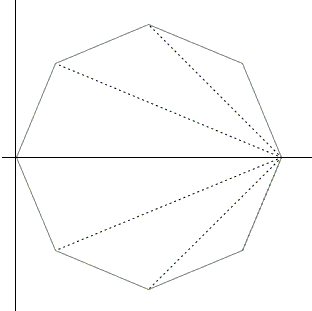Circles in a Regular Polygon
Jeremy Dunn came up with the following claims:
In a regular polygon with the number of sides
- A circle passes through the incenters of all the triangles.
- A circle passes through the centroids of all the triangles.
- If you draw the incircles inside all of the triangles a circle can be drawn tangent to the outside of all of them and tangent to the circle passing through the vertices of the polygon
In the applet below, iCircle is the circle that is announced in 1, cCircle is the one announced in 2, and tCircle answers 3. Mark also the feet of angle bisectors from the selected vertex. These, too, appear concyclic. This circle is denoted aCircle. It looks like in addition to 1-3
- cCircle is tangent to the sides adjacent to the selected vertex.
- The feet of angle bisectors at the selected vertex are concyclic.
| What if applet does not run? |
|Activities| |Contact| |Front page| |Contents| |Geometry|
Copyright © 1996-2018 Alexander BogomolnyIn a regular polygon with the number of sides
- A circle passes through the incenters of all the triangles.
- A circle passes through the centroids of all the triangles.
- If you draw the incircles inside all of the triangles a circle can be drawn tangent to the outside of all of them and tangent to the circle passing through the vertices of the polygon
- cCircle is tangent to the sides adjacent to the selected vertex.
- The feet of angle bisectors at the selected vertex are concyclic.
| What if applet does not run? |
That the centroids are concyclic (#2) follows by homothety from the fact that the midpoints of the sides of the polygon are concyclic. In a triangle, the centroids are \(2/3\) of the way from a vertex to the midpoint of the opposite side. Thus, in the configuration at hand all centroids are \(2/3\) of the way from the selected vertex to the midpoints of the sides. In particular their circumcircle is tangent two the sides of the polygon emanating from the selected vertex.
#5 is definitely true for \(N = 6\) where there are four triangles. If the successive angle bisectors are denoted \(L_{1}, L_{2}, L_{3}, L_{4}\) then the quadrilateral \(L_{1} L_{2} L_{3} L_{4}\) is an isosceles trapezoid and, therefore, cyclic.
It is not difficult to determine the sides of all the triangles. I shall assume the radius of the circumscribing circle to be \(1\). Then each side of the regular \(n\)-gon equals \(2sin(\pi /n)\). The sides of the triangles, i.e., the diagonals of the polygon, could be found in complex numbers starting with the observation that the vertices of the polygon centered at the origin are nothing but the roots of unity: \(\omega _{k} = e^{i2\pi /n} = cos(i2\pi /n) + i\cdot sin(i2\pi /n)\). If shifted by the vector
\[ v_{k} = \omega _{k} + 1 = (cos(i2\pi /n) + 1) + i\cdot sin(i2\pi /n). \]

The lengths \(a_{k}\) of the diagonals are then
\begin{align} a_{k} & = |v_{k}| \\ & = \sqrt{(cos(2\pi k/n) + 1)^{2} + sin^{2}(2\pi k/n)} \\ & = \sqrt{2 + 2cos(2\pi k/n)} \\ & = \sqrt{2(sin^{2}(\pi k/n) + cos^{2}(\pi k/n)) + 2(cos^{2}(\pi k/n) - sin^{2}(\pi k/n))} \\ & = \sqrt{4cos^{2}(\pi k/n)} \\ & = 2|cos(\pi k/n)|. \end{align}
Now, all the triangles are thus well defined by their two sides emanating from the selected vertex and the angles at that vertex all equal to \(1/(n-1)^{th}\) of the angle of a regular n-gon which is \(2\pi(n - 2)/n.\)
In \(\Delta ABC\) with sides \(a, b, c,\) the bisector \(l_{a}\) from vertex A is given by
\[ l_{a}^{2} = \frac{4p(p - a)bc}{(b+c)^2}, \]
where \(p\) is the semiperimeter \(p=(a + b + c)/2\). The angles between successive bisectors are again all equal \(\frac{2\pi (n-2)}{n(n-1)}\) so that all the triangles \(AL_{k}L_{k+1}\) are well defined and their angles at the base could be determined, at least in principle.
The distance \(AI_{k}\) from the selected vertex \(A\) to the incenter \(I_{k}\) of the \(k^{th}\) triangle is found from
\[ AI_{k}^{2} = \frac{(p-a)bc}{p}. \]
... to be continued ...
|Activities| |Contact| |Front page| |Contents| |Geometry|
Copyright © 1996-2018 Alexander Bogomolny73579286
